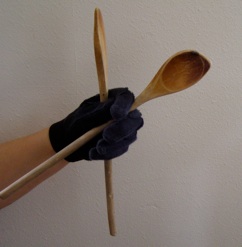Handbell musicians usually start learning the instrument without owning it. The bells may belong to your church, school, or community organization, and a single weekly rehearsal isn’t enough to learn to play any instrument well. It helps to study your sheet music at home, with the director’s permission, and to obtain recordings you can listen to in your car.
I wrote about obtaining rehearsal tracks under Recording permission. This kind of study helps you figure out where your notes fit in, understand how a rhythmic pattern looks and sounds, and learn to track the piece. You also need to build coordination skills to manipulate bells. You may need to ring one bell while continuing the circle for another, change bells, weave, ring four-in-hand, or learn other motor skills. This requires new pathways in the brain built only through repetition of the movement.
There’s really no substitute for playing the actual instrument. (Even children learning piano play on a real instrument.) The handbell community tends to be wonderfully supportive of those learning, and directors are thrilled when ringers volunteer to spend extra time learning their parts. Ask if you can take your bells home, or if you can come in and practice on your own. If your own bells are too large to carry, see if you can borrow the bells an octave higher, which are smaller. You can make simple drawstring bags out of sweatshirt fabric to carry random bells, or you can put soft fabric in a plastic box to protect the bells. (Choose a box with a locking lid.) This is often enough to protect the bells while you take them home and back. Unless you’re taking the bells home for the summer, you’re probably not going to transport foam also. Place the bells on a folded blanket or towels on a table at home, but avoid martellato.
Your director is more likely to grant permission if:
• You’ve proven you’re reliable (e.g. showing up to rehearsals on time) and always treat the bells with care
• You acknowledge that the group’s use of the bells takes priority, and return the bells whenever the group needs them, without fail
• You offer to accept financial responsibility while the bells are in your care
• You return the bells in better shape than you found them, and without making unauthorized changes, like revoicing. (I figure that the day I fail to return borrowed bells in good condition is the day I lose my borrowing privileges in the handbell community.)
• You look for opportunities to reciprocate, perhaps helping with maintenance or administrative tasks.
Sometimes it’s just impossible to remove the main bells from the practice area. Maybe you can arrange to use the bells where they are. You’ll remain welcome so long as you respect the privilege that’s being granted, check in advance that the practice room is available, graciously vacate it for someone with a higher priority activity, clean up after yourself, and take good care of the bells.
If the practice room at your own bell choir is unavailable, ask around to find “closet bells” you might borrow. Churches with bells they’re not using may allow you to borrow them, either to take home or use onsite. See if you can get someone to make the request who knows both you and the music director at the church with the bells you want to use. You might offer to reciprocate, perhaps:
• Make a donation to the church
• Maintain the bells
• Speak about handbells during adult education
• Help with their music program if you have skills they need
• Offer music in worship (for example, if you’re a soloist or member of a small ensemble).
At a minimum, write and thank them for their support, perhaps sending something that can be shared in the church newsletter, especially if your use of the bells contributes to community outreach in some way.
 If all else fails, you can make or buy practice handbells. KidsPlay handbells are a children’s toy, but they do make pitched sounds. You can find them online, in sets of various sizes. You can also make practice handbells from salad dressing bottles filled with wheat, rice, beans, or whatever you happen to have available. Label them or not, as you prefer. They’re most useful for practicing bell changes. Flat salad dressing bottles are best; round salad dressing bottles add the challenge of possibly rolling when you set them down, like bells.
If all else fails, you can make or buy practice handbells. KidsPlay handbells are a children’s toy, but they do make pitched sounds. You can find them online, in sets of various sizes. You can also make practice handbells from salad dressing bottles filled with wheat, rice, beans, or whatever you happen to have available. Label them or not, as you prefer. They’re most useful for practicing bell changes. Flat salad dressing bottles are best; round salad dressing bottles add the challenge of possibly rolling when you set them down, like bells.
Remember to place the bells the same distance apart on the table as the bells you’re simulating, so you get used to the relative positions. You can use other types of bottles, or even wineglasses or kitchen utensils, as practice bells. I have fond memories of “ringing along” to a CD handbell version of Silent Night with my husband one December, as we waved around wooden spoons and spatulas at the dining room table.
For practicing four-in-hand, your best bet again is to borrow bells from wherever you can find them. Because of the way sets are split into cases, you may need to practice with different bells than your usual. A good case to take home is the upper third octave, G#6 to C7. You might use G#6 and B6, or A6 and C7.
 To make your own four-in-hand practice bells, try wooden spoons. The handles are easier to work with than bottles, especially if you use spoons with shorter handles less likely to catch on things. Pay attention to the direction each spoon bowl faces relative to the other. Here I’m ringing Shelley, and the “clappers” face the same way; both spoons have the flat part facing the same direction.
To make your own four-in-hand practice bells, try wooden spoons. The handles are easier to work with than bottles, especially if you use spoons with shorter handles less likely to catch on things. Pay attention to the direction each spoon bowl faces relative to the other. Here I’m ringing Shelley, and the “clappers” face the same way; both spoons have the flat part facing the same direction.
 At right, I’m practicing ringing the primary bell of a “ring and knock” configuration. The flat part of each spoons faces at right angles to the other spoon, just as the clappers would. This is a side view so you can see the spoons more clearly.
At right, I’m practicing ringing the primary bell of a “ring and knock” configuration. The flat part of each spoons faces at right angles to the other spoon, just as the clappers would. This is a side view so you can see the spoons more clearly.
When you become a solo ringer, you’ll probably practice at your bell choir location for a while. Sometime within the first year you seriously pursue solo ringing, you’ll realize you need your own set of bells to advance. Nearly every highly accomplished solo ringer I can think of has owned her own bells for some length of time. It’s just too difficult to travel and set up every time you want to practice, which, for me, meant a very long and tiring practice session to justify the trip and setup/teardown time. You’ll also start wanting to customize the bell set, adjusting clapper tensions and voicing for the best results. When you want to perform, you’ll have to negotiate for the use of the bells, or be limited to the venue where they’re located. I’ll talk another time about choosing your own bells. It’s possible to rent from the manufacturers, but it’s very expensive. For now, be aware that reaching your full potential as a solo handbell musician means, at some point, investing in owning the instrument.
Copyright © 2012 Nancy Kirkner, handbells.com